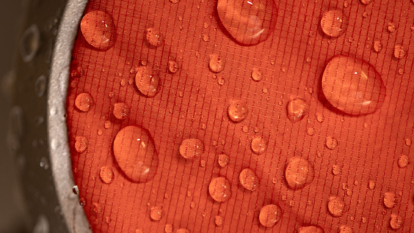A Strong Finish
Perfluorinated chemicals, or PFAS, made for great waterproofing but are also a lasting, pervasive threat to our health. That’s why we spent nearly 15 years finding a way to make our gear without them that didn't compromise performance. For Spring 2025 and beyond, all our new styles are made without intentionally added PFAS.
Eight of our designers and materials experts gather around a table, 10 by 10, in the Forge, Patagonia’s research and development facility in Ventura, California. Alongside sewing machines, 3D printers, darning machines, spools of tape, and container upon container of zippers, snaps, elastics and labels, nearby bolts of fabric soar to the ceiling: Big Sur Blue, Gin Green and Adzuki Red, the gang’s all here.
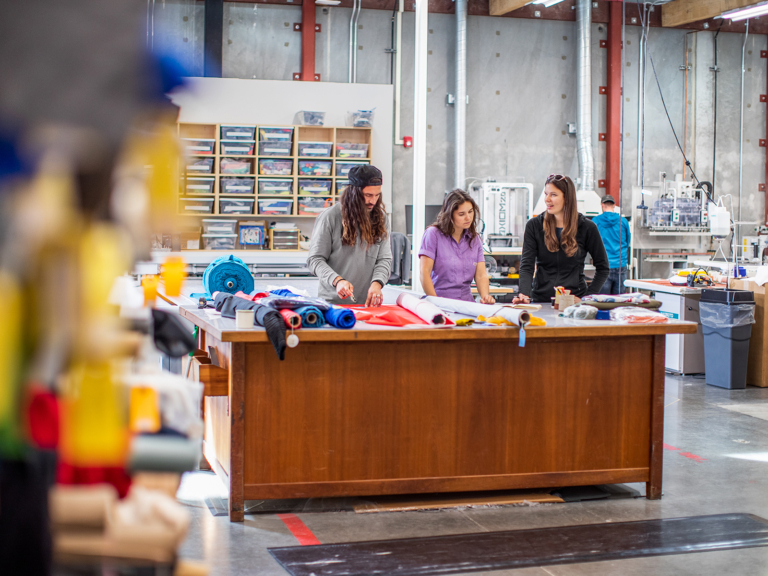
At the Forge, Patagonia’s research and development facility in Ventura, California, materials experts (left to right) Aaron Oder, Lauren Woodward and Laura Hoch look over samples of materials made without PFAS. Photo: Tim Davis
But the octet is buzzing about a new fabric that’s just arrived from Vietnam and been sewn into a prototype ski/snowboard jacket. It will be our first waterproof finish and membrane built with a DWR (durable water repellent) coating that isn’t made with per- and polyfluorinated chemicals (usually abbreviated as PFAS). These synthetic compounds are known for water repellency and nonstick pans, but also for polluting rivers, increasing cancer risk and staying in the environment—and our bodies—indefinitely.
It seems like they might have a winner. A material developer splashes some water on the jacket. The water beads up like it should.
Then comes the stain.
“This was an ‘oh shit’ moment for us,” says Malinda Scheff, a Patagonia material supplier quality manager. What the group saw that day in May 2018 was a sizeable oil stain courtesy of residual sewing-machine grease embedded in the fabric. It was invisible when the garment was dry, but with that particular chemistry, when the water hit, so did the stain. Avoiding machine grease wasn’t a problem we could solve. But it was an inevitability we’d have to account for with a new DWR finish, because treatments made without PFAS don’t have the same resistance to oil as fluorinated chemistries do. “It was like going back to square one,” Scheff says.
On our journey toward less harmful DWR finishes, that was one of several disappointing experiences before finally landing where Patagonia is now. For Spring 2025 and beyond, all our new products are made without intentionally added PFAS. That means we do not add fluorinated chemistries to achieve a specific function or technical feature in our gear.
That goal coincides with restrictions on the use of PFAS in California and New York. There are also proposed limitations in several other states and the European Union. (PFAS, which stands for per- and polyfluoroalkyl substances, is the latest terminology for this wide class of chemicals. If your Patagonia gear is made without intentionally PFAS, it’s also made without intentionally added PFCs, PFOS and PFOA.)
So how could PFAS be unintentionally added? There are more than 14,000 PFAS chemistries regulated by the new laws that went into effect January 1, 2025. Only a few of these chemistries are actually used for a functional or technical purpose in clothing. These are the chemistries we are not adding to our products. But the industry is still learning how and where the other chemistries might show up in different components of apparel and manufacturing processes. We’re staying close to the science to ensure our supply chain and products reflect the most up-to-date research on these chemistries and their potential impacts on our health and the planet’s.
In short, if it’s a chemistry that’s regulated by the new laws, Patagonia is not using it.
It’s taken more than 15 years to get where we are today. Scheff and her colleagues say we’re close to calling this done. Others say it’s about damn time. What’s indisputable is that getting here without PFAS and without compromising performance was harder than we imagined and provided important, humbling lessons.
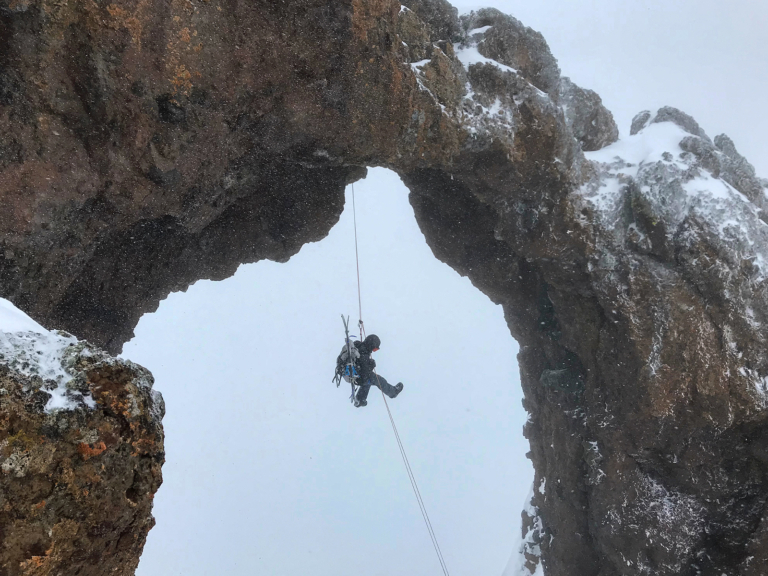
Testing fabric and gravity. Walker Ferguson abseils off a mountaintop arch in the Northern Absarokas, Wyoming. Photo: Beau Fredlund
PFAS, PFCs, PFOS and PFOA: The gamut of fluorinated chemicals reads like alphabet soup. First produced in the 1950s, these chemicals have subtly different molecular structures with similar functions. They’re strong, heat-stable, and water- and oil-repellent, which has made them a fixture in nonstick cookware, stain-resistant carpeting, food wrappers and fire-extinguishing foam. Brands like Patagonia have used these durable fluorocarbons as a water-repellent finish on most synthetic products. In waterproof gear, they’re also used on the membrane—the barrier in your garment that keeps water out.
Perfluorinated chemicals are good at their job. When used in gear, they’re so strongly bonded to the fabric that wearing it doesn’t present a health risk. For apparel products, the primary problem is in the manufacturing phase, when the chemicals have the potential to contaminate water or food. Down the line, if that product is thrown away, the fluorocarbons can make recycling harder and impact soil and water around landfills. And they’re called “forever chemicals” because they can persist for thousands of years.
They might be coursing through you right now. Studies show that 98 percent of the US population has fluorocarbons in their system. There are also links to increased cancer risk, hormone disruption, decreased immunity and impacts to reproductive health. In 1999, PFOA got worldwide attention in a lawsuit against DuPont—which had been manufacturing these chemicals in Parkersburg, West Virginia—and again in 2019 in Dark Waters, the film adaptation of the case.
Environmentally, the manufacturing of fluorinated chemicals is increasing greenhouse gas emissions and wreaking havoc on soil, air and water quality. They travel, too. These chemicals have been found in bald eagles and fish in the contiguous US, polar bears in Alaska, and pilot whales in the Faroe Islands.
Given all the dangers of PFAS, keeping them in our gear wasn’t an option. In 2006, we began research around DWR finishes made without PFOAs (the most prevalent fluorocarbon at the time), started R&D trials for DWR finishes without PFCs in 2015, and launched our first DWR product made without PFCs in 2019. We were on it, sure, but we can’t argue without a little skepticism.
As John Oliver said—about us and other brands—on Last Week Tonight: “All of these companies insist that they are working to remove PFAS from their products completely in the coming months and years. And I hope that that is true, but we have heard things like that before and yet, here we fucking are.”
Eager to switch, in 2016 we pivoted from C8—long-chain PFAS then considered the most damaging of all fluorocarbons—to the seemingly less harmful C6. Then new studies discovered C6 isn’t any easier on the environment.
“C6 still contains fluorocarbons,” Scheff explains. “It’s like some plastics that take less time to break down. At the time, that was what everyone was doing and what our mills had on hand. Looking back, we could’ve done the work then to figure it out. It’s what we call a ‘regrettable substitution.’” (That’s common parlance among chemists—replacing a harmful chemical with something that’s, often unknowingly, just as bad. Like Sting sings in Another Day, sometimes “it’s hard to tell the poison from the cure.”)
After the C6 fiasco, Patagonia chemists like Laura Hoch dug into the makeup of chemistries without PFAS to avoid more regrettable substitutions. Hoch had a connection to the work. She spent her early years in Parkersburg, where her dad had worked for DuPont. “Not so fun fact: Yes, I drank the water,” she says.
At times, other outdoor brands seemed to beat us to creating chemistries without PFAS—except they hadn’t. Those products had tears, seam slippage and other mishaps before getting switched back to fluorinated treatments. Or they created some successes without PFAS, but not for pinnacle products that really need to withstand the elements.
The exact chemistry we use depends on material, product and intended purpose. Ours are typically based on hydrocarbons (think polymers and waxes) or silicones. Once we had alternative chemistries we’d be proud of, we tested them on our top five styles with DWR finishes, like Nano Puff® jackets.
Solutions weren’t one-size-fits-all. One option without PFAS might work on nylon but not on polyester. And it wasn’t just water repellency we were testing. Was there chalking or seam slippage? Are there abrasion issues? And how good does it look? We learned from our oil-stained prototype that our product quality team had to work with factories on sewing and finishing processes. We’re still finding ways to test if some chemistries are more susceptible to stains and oil than others.
At times, the challenge wasn’t in the lab but with our partners. When we were ready to make the finishes and membranes for our Nano Puff styles without PFAS, it was our supplier who refused, citing that they needed more time and experience with the treatment. Other times, something that worked well in the lab didn’t stand up in the wild.
“We have our Ironclad Guarantee, so we can’t just smack a new chemistry on a product and send it out into the world knowing it could fail,” says Karba, a former environmental researcher at Patagonia. “We need to guarantee that it’ll work in the lab and field. That’s why it’s taken years to transition to that functional, durable chemistry that doesn’t have PFCs or PFAS.”
All our waterproof finishes and membranes, including those made without PFAS, must meet Patagonia’s rigorous H₂No® Performance Standard. It’s intentionally demanding so that we say yes only to products that guarantee long-lasting waterproof performance and breathability. After passing the lab check, these products are tested during skiing/snowboarding seasons all over the world. Key findings come out of field testing: When you wipe cheeseburger-covered hands on your Powder Town Jacket, that oily residue will stain the jacket until you wash it. You might also see “wet out,” when the exterior of the fabric looks wet but the inside—and you—aren’t wet at all. These are the trade-offs we can live with because they’re easily remedied with proper care and repair (see “A Clean Shell Is a Happy Shell” below).
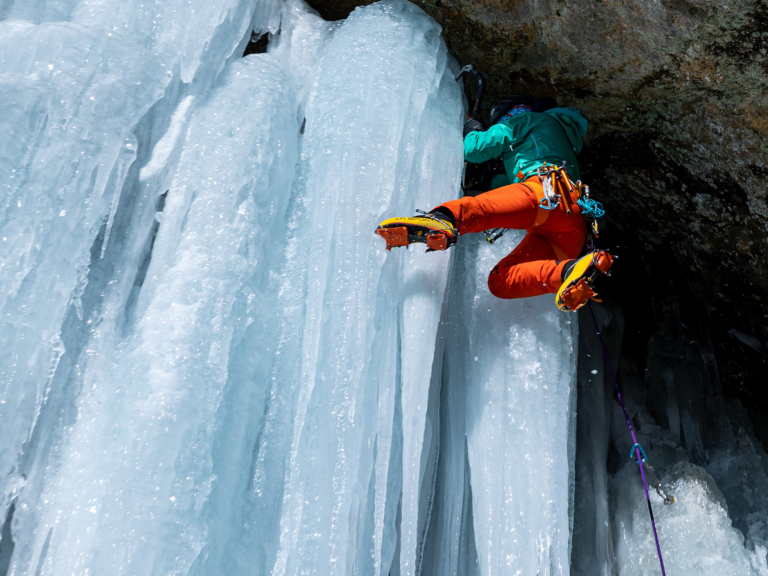
Things are looking up. Patagonia Ambassador Majka Burhardt ice climbs Jaws (WI5) near her home in New Hampshire. Photo: Joe Klementovich
Fall 2019 brought the first of many wins: our first DWR products made without PFAS, like the Pack Rain Covers. Two years later brought our first technical products for alpine climbing made without PFAS, the Dual Aspect Jacket and Bibs—that was huge. Converting to these alternatives on both the shell surface and interior membrane, while also meeting a customer’s definition of “waterproof,” is a high bar to pass, requiring additional innovation, testing and time. For the Spring 2023 season, we debuted a rain jacket without PFAS, our stalwart Torrentshell, which got us to 66 percent of all fabrics with a DWR finish made without PFAS.
But it’s about more than just our company, as we work with our suppliers and mills to prioritize shifts that will move the needle industry-wide. Scheff remembers one supplier who told her team that if the factory began using our chemistry, they’d use it on other brands’ waterproof gear, too—whether those brands asked for the chemistries without PFAS or not. That’s a big win considering the resistance we got from suppliers when we started to move away from C6 in 2016.
Now we’ve made all our new waterproof membranes and finishes for Spring 2025 and beyond without intentionally added PFAS.
“We’ve moved slowly because we want to make sure the performance is there,” Scheff says. “And sometimes getting that perfect marriage of fabric and chemistry means completely redesigning a piece. I’m just waiting for the day I can pop the champagne.”
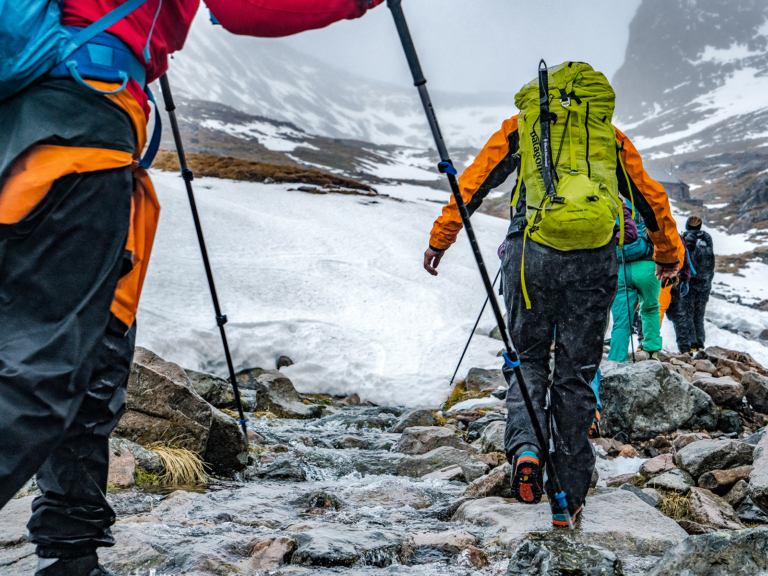
Field-testing alpine gear during a Patagonia climbing event in Scotland. Photo: Jason Thompson
The Path to Gear Made without PFAS
Milestones and mistakes on our nearly 20-year journey.
2006
Studies expose how fluorinated chemistries—the stuff that makes waterproof gear hydrophobic—endanger our health. We start researching DWR (durable water repellent) finishes made without PFOA (one of the more commonly used fluorocarbons at the time).
2009
We begin converting our waterproof chemistries from long-chain C8 molecules—such as PFOA and PFOS, considered the worst of the bunch—to C6.
2011
Greenpeace’s “Detox” campaign calls out Nike and Adidas for using polluting chemicals. We aren’t named but know we’re a part of the problem, too.
2015
We kick off R&D trials for DWR finishes made without PFAS.
2016
So long, C8. We finish the move from the long-chain fluorocarbon to the (seemingly) less insidious C6 across all water-repellent finishes and membranes.
2017
Dammit. Research emerges that C6 is just as damaging. This is what chemists call a “regrettable substitution.” It reinforces our commitment to eliminate “forever chemicals” forever.
2019
We introduce our first round of gear made with DWR finishes built without PFAS, including select products like the Pack Rain Covers.
2021
Our first slate of technical gear made without PFAS—built with waterproofing on both the garment’s finish and the inner membrane—launches with the Dual Aspect Jacket and Bibs, and Micro Puff® Storm.
2022
Getting closer. Most All Mountain Snow product and non-waterproof Patagonia products with a DWR finish are made without PFAS in both fabric and trim. In total by volume, 66% of our products with DWR finishes are made without PFAS.
2023
The lineup gets longer: All H₂No® Performance Standard Alpine rainwear is made without PFAS, including the redesigned Torrentshell. Now, 98% of our products with DWR finishes are made without PFAS.
2024
Almost there. 99% of our fabric, by weight, with water-repellent chemistries is made without PFAS.
2025
For Spring 2025 and beyond, all our new styles will be made without intentionally added PFAS.
Updated August 2024
